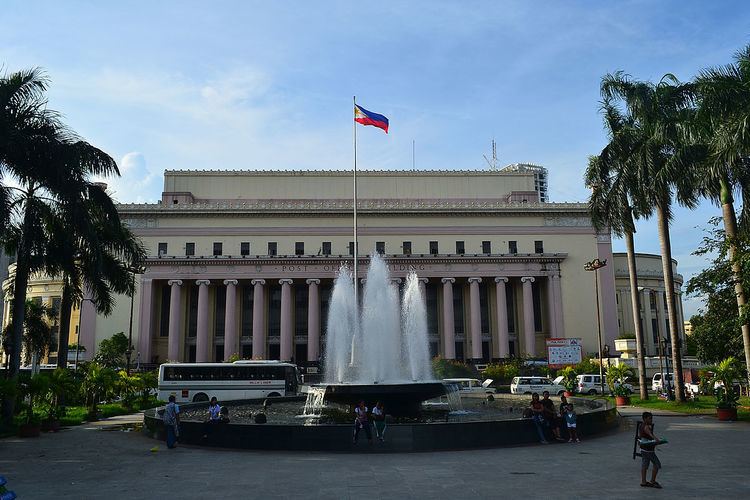Phone +63 919 616 3603 Architect Juan M. Arellano | ||
 | ||
Civil engineer Pedro Siochi y Angeles (1886-1951) who is a native of Malabon, Rizal and graduated with a degree in Civil Engineering from the University of Ghent, Belgium Main contractor the Pedro Siochi and Company Hours Open today · 8AM–6PMMonday8AM–6PMTuesday8AM–6PMWednesday8:30AM–6:30PMThursday8AM–6PMFriday8AM–6PMSaturday8AM–6PMSunday8:30AM–6:30PM Owner Government of the Philippines Similar Liwasang Bonifacio, Manila Metropolitan Theater, National Museum of Fine Arts, Jones Bridge, Manila City Hall | ||
The Manila Central Post Office is the central post office of the city of Manila, Philippines. It is the head office of the Philippine Postal Corporation, and houses the country's main mail sorting-distribution operations.
Contents
Designed by Juan M. Arellano and Tomás Mapúa, the post office building was built in neoclassical architecture in 1926. It was severely damaged in World War II, and rebuilt in 1946 preserving most of its original design.
The location of the Post Office building in the Ermita district of the city east of Intramuros, was part of the plan of Daniel Burnham for the city of Manila, which placed the building on the frontage of the Pasig River for easy water transportation of mails. Its central location with converging avenues made the building readily accessible from all sides. The building's main entrance faces the Liwasang Bonifacio.
The construction of this building started in 1936 under the supervision of the engineering firm Pedro Siochi and Company. It was finished before the outbreak of war in 1941.
History
This official transmitter of mail, money and goods traces its beginnings to Act No. 462 of the Philippine Commission on September 15, 1902, creating the Bureau of Posts. Postal service in the country, albeit crude and slow, began during the Spanish period with horse-riding couriers till it reached the marked improvements which the Americans initiated. The present building which houses the bureau hums daily with brisk postal service.
Now under the Ministry of Public Works, Transportation and Communication, the Bureau of Posts, now houses a modern and efficient look with its mechanized automatic letter-sorting machine, new Postal Code, Metropolitan Airmail Network, motorized letter carriers and all other new facilities.
Architecture
The Manila Post Office was strategically located by Daniel Burnham at the foot of Jones Bridge because of two reasons. First was that the Pasig River could be used conveniently as an easy route for delivering mail and secondly, the post office could be accessible from all sides including Quiapo, Binondo, Malate, and Ermita.
Considered to be Juan Arellano's magnum opus, it was designed in the neoclassical style that expressed order and balance. It was built in 1926 and was worth one million pesos. Fronting the huge, rectangular volume are the 16 Ionic pillars lined that are lined up above the steps just before entering the lobby. The main body of the building is capped by a recessed rectangular attic storey and flanked and buttressed by two semi-circular wings. Inside, the main lobby has subsidiary halls at each end housed under the semi-circular spaces roofed with domes.
The plans on completing the post office building was made public on November 28, 1927 but the awarding of the project happened a year after in 1928. From August 2, 1920 up to January 9, 1922, the foundation was laid out. The work was put on hold because of the scarcity of funds but was reported to be 56% complete towards the end of the year. The completion of the building was continued on February 1928.
Proposals for the completion of the Manila Post Office Building were made known on November 28, 1927 but the awarding of the project was made only in 1928.
